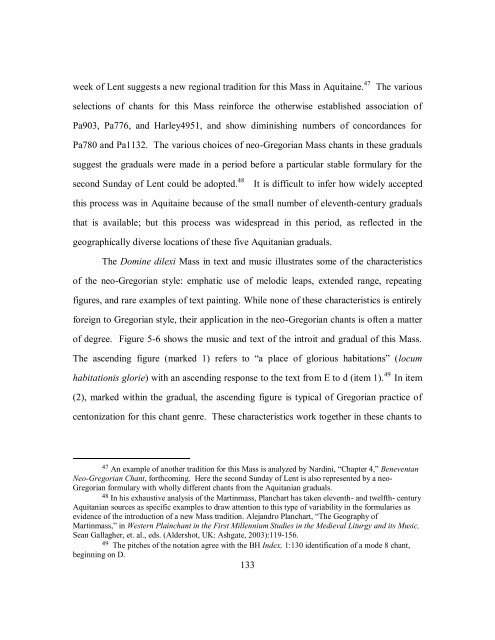Front Matter Template - The University of Texas at Austin
Front Matter Template - The University of Texas at Austin
Front Matter Template - The University of Texas at Austin
You also want an ePaper? Increase the reach of your titles
YUMPU automatically turns print PDFs into web optimized ePapers that Google loves.
week <strong>of</strong> Lent suggests a new regional tradition for this Mass in Aquitaine. 47 <strong>The</strong> various<br />
selections <strong>of</strong> chants for this Mass reinforce the otherwise established associ<strong>at</strong>ion <strong>of</strong><br />
Pa903, Pa776, and Harley4951, and show diminishing numbers <strong>of</strong> concordances for<br />
Pa780 and Pa1132. <strong>The</strong> various choices <strong>of</strong> neo-Gregorian Mass chants in these graduals<br />
suggest the graduals were made in a period before a particular stable formulary for the<br />
second Sunday <strong>of</strong> Lent could be adopted. 48 It is difficult to infer how widely accepted<br />
this process was in Aquitaine because <strong>of</strong> the small number <strong>of</strong> eleventh-century graduals<br />
th<strong>at</strong> is available; but this process was widespread in this period, as reflected in the<br />
geographically diverse loc<strong>at</strong>ions <strong>of</strong> these five Aquitanian graduals.<br />
<strong>The</strong> Domine dilexi Mass in text and music illustr<strong>at</strong>es some <strong>of</strong> the characteristics<br />
<strong>of</strong> the neo-Gregorian style: emph<strong>at</strong>ic use <strong>of</strong> melodic leaps, extended range, repe<strong>at</strong>ing<br />
figures, and rare examples <strong>of</strong> text painting. While none <strong>of</strong> these characteristics is entirely<br />
foreign to Gregorian style, their applic<strong>at</strong>ion in the neo-Gregorian chants is <strong>of</strong>ten a m<strong>at</strong>ter<br />
<strong>of</strong> degree. Figure 5-6 shows the music and text <strong>of</strong> the introit and gradual <strong>of</strong> this Mass.<br />
<strong>The</strong> ascending figure (marked 1) refers to “a place <strong>of</strong> glorious habit<strong>at</strong>ions” (locum<br />
habit<strong>at</strong>ionis glorie) with an ascending response to the text from E to d (item 1). 49 In item<br />
(2), marked within the gradual, the ascending figure is typical <strong>of</strong> Gregorian practice <strong>of</strong><br />
centoniz<strong>at</strong>ion for this chant genre. <strong>The</strong>se characteristics work together in these chants to<br />
47 An example <strong>of</strong> another tradition for this Mass is analyzed by Nardini, “Chapter 4,” Beneventan<br />
Neo-Gregorian Chant, forthcoming. Here the second Sunday <strong>of</strong> Lent is also represented by a neo-<br />
Gregorian formulary with wholly different chants from the Aquitanian graduals.<br />
48 In his exhaustive analysis <strong>of</strong> the Martinmass, Planchart has taken eleventh- and twelfth- century<br />
Aquitanian sources as specific examples to draw <strong>at</strong>tention to this type <strong>of</strong> variability in the formularies as<br />
evidence <strong>of</strong> the introduction <strong>of</strong> a new Mass tradition. Alejandro Planchart, “<strong>The</strong> Geography <strong>of</strong><br />
Martinmass,” in Western Plainchant in the First Millennium Studies in the Medieval Liturgy and its Music,<br />
Sean Gallagher, et. al., eds. (Aldershot, UK: Ashg<strong>at</strong>e, 2003):119-156.<br />
49 <strong>The</strong> pitches <strong>of</strong> the not<strong>at</strong>ion agree with the BH Index, 1:130 identific<strong>at</strong>ion <strong>of</strong> a mode 8 chant,<br />
beginning on D.<br />
133

















